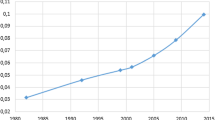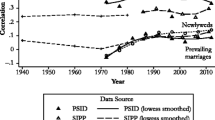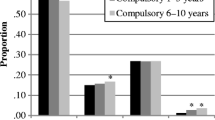Abstract
In this paper, we describe mating patterns in the USA from 1964 to 2017 and measure the impact of changes in marital preferences on between-household income inequality. We rely on the recent literature on the econometrics of matching models to estimate complementarity parameters of the household production function. Our structural approach allows us to measure sorting along multiple dimensions and to effectively disentangle changes in marital preferences and in demographics, addressing concerns that affect results from existing literature. We answer the following questions: Has assortativeness increased over time? Along which dimensions? To what extent can the shifts in marital preferences explain inequality trends? We find that, after controlling for other observables, assortative mating in education has become stronger. Moreover, if mating patterns had not changed since 1971, the 2017 Gini coefficient between married households would be 6% lower. We conclude that about 25% of the increase in between-household inequality is due to changes in marital preferences. Increased assortativeness in education positively contributes to the rise in inequality, but only modestly.














Similar content being viewed by others
Notes
The survey of Stevenson and Wolfers (2007) tracks the changes that the institution of the family has gone through in recent decades, and presents several significant research questions that need to be answered.
The methodology consists of finding a log-linear model with good fit to explain a contingency table with the distribution of income by percentile (plus one category containing zero-income observations). Then, one can compute predicted frequencies after removing certain regressors to reproduce counterfactual situations.
Schwartz (2010) uses the ratios between the median income of the top 20% households (high class) over the median income of the middle 60% (medium class) or the median income of the top 20% (low class) as measures of inequality.
As for Greenwood et al. (2014), we hereby refer to the revised findings published in the corrigendum.
Alternatively, one could put an additional restriction on the parameters σ, for instance σ = 1 on each market. Ciscato et al. (forthcoming) propose to normalize the social gain \(\mathcal {W}(A,\sigma )\).
In addition, in CPS waves before 1976, there is no state variable at the household level. Only broad geographical areas are reported.
The 5-level variable is constructed as follows: (1) below high school degree, (2) high school degree, (3) some college, (4) college degree, and (5) 5+ years of college. With 4 levels only, we distinguish: (1) below high school degree, (2) high school degree, (3) college degree, and (4) 5+ years of college.
The number of weeks working in the past year is usually available as a continuous variable. However, it is sometimes only available as a grouped variable, which we use to proxy the number of weeks worked in the past year.
Comparing summary statistics before and after 1971 suggests that most Hispanics declared themselves as White, whereas the category Others mostly contains Asians before 1988.
We also exclude students aged more than 23 by combining data on school attendance and reasons for not participating to the labor market.
More precisely, each cohort t of young men matches with the cohort t + 1 of young women.
The trends for the median age at first marriage have been estimated with CPS data by the Fertility and Family Statistics Branch of the US Census Bureau and are available online: https://www.census.gov/data/tables/time-series/demo/families/marital.html. Details about the estimation method can be found in ?[ ()Chapter 9]siegel2004methods. The 1970 and the 1980 Census and the American Community Survey (ACS) contain survey data about the year of marriage: a comparison of the estimated CPS trends with these data sources reveals that the estimates are indeed accurate.
The graph also shows the discrepancy in the education variable in 1992, as a large share of the population previously categorized as having a high school degree now appears in the “Some College” category.
The share of employed people may appear extremely high in some cases (for men at the beginning of the period for example), but this may be due to our sample selection criteria based on age and marital status. In addition, we consider a person as employed as long as we are able to compute a wage, that is, as long as she worked in the past year.
In practice, we first compute \((diag(E_{\hat {\pi }}[x_{1991}^{\prime }x_{1991}]))^{-1/2}\) for men’s population in 1991, and then use it as a scaling factor for every cross-section. We do the same for women.
In fact, in spite of the increasing median age of first marriage, most people still get married before they turn 35. The share of married people in a cohort is indeed approximately constant after 35 (see Chapter 1, Browning et al. 2014.
The difference between the median age for men and for women is approximately constant over the time period considered, and is around 2 years (see Fig. 1).
Precisely, we replace wages by the variable log(1 + wa) where wa are (possibly 0) annual earnings.
Alternatively, we could compare the counterfactual matching P(2017, 2017; 1971) with the actual frequencies observed in the data, rather than those predicted by the model. However, since the model does an excellent job in reproducing the actual frequencies, the two exercises yield similar results.
The only trend that we find is a slight—and barely significant—decrease of the negative interaction between men’s wage and women’s working hours. This parameter may partly capture the wife’s wealth effect on labor supply.
However, the effect is small and is not displayed in Fig. 14.
As discussed by DG (see Appendix C in particular) and Ciscato et al. (forthcoming), the distributional assumption on the stochastic terms of the marital payoff functions is such that the choice model (1) is logit and benefits from the property of the independence of irrelevant alternatives. Under this assumption, treating the composition of the married population as exogenously given does not affect the empirical findings.
References
Agresti A (2007) An Introduction to Categorical Data Analysis, 2nd edn. Wiley, Hoboken
Agresti A (2013) Categorical Data Analysis, 3rd edn. Wiley, Hoboken
Atkinson MP, Glass BL (1985) Marital age heterogamy and homogamy, 1900 to 1980. J Marriage Fam 47(3):685–691
Becker GS (1973) A theory of marriage: Part i. J Polit Econ 81(4):813–846
Becker GS (1974) A theory of marriage: Part ii. J Polit Econ 82(2):S11–S26
Becker GS (1991) A Treatise on the Family. Harvard University Press, Cambridge
Blackwell DL (1998) Marital homogamy in the United States: the influence of individual and paternal education. Soc Sci Res 27(2):159–188
Browning M, Chiappori PA, Weiss Y (2014) Economics of the Family. Cambridge University Press, Cambridge
Burtless G (1999) Effects of growing wage disparities and changing family composition on the us income distribution. Eur Econ Rev 43(4):853–865
Cancian M, Reed D (1998) Assessing the effects of wives’ earnings on family income inequality. Rev Econ Stat 80(1):73–79
Chiappori PA, Salanié B, Weiss Y (2017) Partner choice, investment in children, and the marital college premium. Am Econ Rev 107(8):2109–67
Choo E, Siow A (2006) Who marries whom and why. J Polit Econ 114 (1):175–201
Ciscato E, Galichon A, Goussé M (forthcoming) Like attract like? a structural comparison of homogamy across same-sex and different-sex households. Journal of Political Economy
Dupuy A, Galichon A (2014) Personality traits and the marriage market. J Polit Econ 122(6):1271–1319
Dupuy A, Weber S (2018) Marital patterns and income inequality. Tech. rep
Eika L, Mogstad M, Zafar B (forthcoming) Educational assortative mating and household income inequality. Journal of Political Economy
Fernández R, Rogerson R (2001) Sorting and long-run inequality. Q J Econ 116(4):1305–1341
Fernández R, Guner N, Knowles J (2005) Love and money: a theoretical and empirical analysis of household sorting and inequality. Q J Econ 120(1):273–344
Fryer RG (2007) Guess who’s been coming to dinner? trends in interracial marriage over the 20th century. J Econ Perspect 21(2):71–90
Fu X, Heaton TB (2008) Racial and educational homogamy: 1980 to 2000. Sociol Perspect 51(4):735–758
Galichon A, Salanié B (2015) Cupid’s invisible hand: social surplus and identification in matching models. Tech. rep., SSRN Working Paper Series
Greenwood J, Guner N, Kocharkov G, Santos C (2014) Marry your like: assortative mating and income inequality. Am Econ Rev Pap Proc 104(5):348–353
Greenwood J, Guner N, Kocharkov G, Santos C (2016) Technology and the changing family: a unified model of marriage, divorce, educational attainment, and married female labor-force participation. Am Econ J Macroecon 8(1):1–41
Heckman JJ (1979) Sample selection bias as a specification error. Econometrica 47(1):153–161
Johnson RA (1980) Religious Assortative Mating in the United States. Academic Press, Cambridge
Kalmijn M (1991a) Shifting boundaries: trends in religious and educational homogamy. Am Sociol Rev 56(6):786–800
Kalmijn M (1991b) Status homogamy in the United States. Am J Sociol 97 (2):496–523
Kremer M (1997) How much does sorting increase inequality?*. Q J Econ 112 (1):115–139
Liu H, Lu J (2006) Measuring the degree of assortative mating. Econ Lett 92(3):317–322
Mare RD (1991) Five decades of educational assortative mating. Am Sociol Rev 56(1):15–32
Qian Z, Preston SH (1993) Changes in American marriage, 1972 to 1987: availability and forces of attraction by age and education. Am Sociol Rev 58(4):482–495
Schmitt J (2003) Creating a consistent hourly wage series from the current population survey’s outgoing rotation group 1979-2002. Tech. rep., CEPR Working Paper
Schoen R, Wooldredge J (1989) Marriage choices in North Carolina and Virginia, 1969-71 and 1979-81. J Marriage Fam 51(2):465–481
Schwartz CR (2010) Earnings inequality and the changing association between spouses’ earnings. Am J Sociol 115(5):1524
Schwartz CR, Graf NL (2009) Assortative matching among same-sex and different-sex couples in the united states, 1990–2000. Demogr Res 21(28):843
Schwartz CR, Mare RD (2005) Trends in educational assortative marriage from 1940 to 2003. Demography 42(4):621–646
Shapley LS, Shubik M (1971) The assignment game i: the core. Int J Game Theory 1(1):111–130
Siegel JS, Swanson DA (2004) The Methods and Materials of Demography. Elsevier Academic Press, California
Smits J, Ultee W, Lammers J (1998) Educational homogamy in 65 countries: an explanation of differences in openness using country-level explanatory variables. Am Sociol Rev 63(2):264–285
Stevens G, Schoen R (1988) Linguistic intermarriage in the United States. J Marriage Fam 50(1):267–279
Stevenson B, Wolfers J (2007) Marriage and divorce: changes and their driving forces. J Econ Perspect 21(2):27–52
Western B, Bloome D, Percheski C (2008) Inequality among American families with children, 1975 to 2005. Am Sociol Rev 73(6):903–920
Acknowledgments
The authors thank the editor and two anonymous reviewers for very helpful comments. Additionally, the authors acknowledge the insightful comments of Arnaud Dupuy, Alfred Galichon, Sonia Jaffe, Andreas Steinhauer, Frederic Vermeulen, Paul Vertier, and seminar participants at University of Chicago, Sciences Po Paris, and the RES Symposium of Junior Researchers. The data used in this paper are available from IPUMS-CPS, University of Minnesota, www.ipums.org.
Funding
Weber is grateful for financial support from the France Chicago Center Exchange Fellowship and for the hospitality of the CEHD at the University of Chicago where part of this paper was written.
Author information
Authors and Affiliations
Corresponding author
Ethics declarations
Conflict of interest
The authors declare that they have no conflict of interest.
Additional information
Responsible editor: Junsen Zhang
Publisher’s note
Springer Nature remains neutral with regard to jurisdictional claims in published maps and institutional affiliations.
Appendices
Appendix A: Neutrality of optimal matching
According to DG, the equilibrium matching is described by the function 2. Take the log of π(x,y) so that:
The first component is x′By: without the identification assumption with multiple markets described in Section (3.4), we are still able to identify B = A/σ unequivocally. In fact, under any assumption to disentangle A from σ, a sample (X,Y ) yields a unique estimate \(\hat {B}\).
As concerns the second and third components a(x)/σ and b(x)/σ, define \(\tilde {a}(x)=\exp (a(x)/\sigma )\) and \(\tilde {b}(x)=\exp (b(x)/\sigma )\). We can rewrite (2) as:
and plug it into the accounting constraints:
DG suggest solving this system by means of an IPFP algorithm. Notice that we can conclude that, for a given set of parameters B, there is a unique solution given by vectors \(\tilde {a}^{*}\) and \(\tilde {b}^{*}\), and thus a unique solution π∗.
Appendix B: Improvements to the estimation procedure
Depending on the year, our samples may contain many individuals. However, for computational reasons, estimation can only be performed on a subset of the population. Doing so, we do not make full use of the data to compute the empirical variance-covariance matrix. If the subsample’s size is too small, this may even introduce some bias in the estimates. Since the estimation strategy relies on matching the theoretical co-moments to the empirical counterparts, we pick a random subsample whose co-moments of interest are close to those of the full sample. Hence, we use the following procedure to select the subsamples:
Procedure 1
Let N be the number of couples in the population:
-
Step 0.
Compute the empirical variance-covariance \(\hat {V}\equiv E[XY]\) with the full sample
-
Step 1.
Draw a subsample of size n < N and compute the empirical variance covariance matrix \(\hat {V}_{n}\)
-
Step 2.
Check if \(|\hat {V}-V_{n}|<\epsilon \times \hat {V}\) for a given level of precision 𝜖.
-
Step 3.
If step 2 is satisfied, use Vn and the corresponding subsample to estimate the affinity matrix, otherwise repeat steps 1–3.
Appendix C: Samples
Appendix D: Additional figures
Relevant cross-interactions. Sample used: baseline A. The figures display the estimated trends of the off-diagonal elements of the marital preference parameter matrix A that have some relevance in our decomposition exercise in Section 6.4. In the labels, the first trait is the husband’s and the second is the wife’s, e.g., Wage-Educ refers to the interaction between the husband’s wage rate and the wife’s education
Sample selection by median age. Sample used: check 1 (see Appendix C). The figures compare our baseline results on estimated trends of the diagonal elements of the marital preference parameter matrix A with those obtained using a subsample of couples where at least one partner is aged between the contemporaneous female median age at first marriage (minus 2) and the contemporaneous male median age at first marriage (plus 2)
Sorting on annual earnings. Sample used: check 2 (see Appendix C). The figures show estimated trends of the diagonal elements of the marital preference parameter matrix A when annual earnings are used instead of wages
All couples and working couples (where both partners work). Sample used: check 3 (see Appendix C). The figures compare our baseline results on estimated trends of the diagonal elements of the marital preference parameter matrix A with those obtained using a subsample of couples where both spouses work
All couples and childless couples. Sample used: check 4 (see Appendix C). The figures compare our baseline results on estimated trends of the diagonal elements of the marital preference parameter matrix A with those obtained using a subsample of childless couples
Sorting on potential income. Sample used: check 5 (see Appendix C). The figures compare our baseline results on estimated trends of the diagonal elements of the marital preference parameter matrix A with those obtained using a measure of potential wages
Education omitted. Sample used: check 7 (see Appendix C). The figures compare our baseline results on estimated trends of the diagonal elements of the marital preference parameter matrix A with those obtained when purposefully omitting education
Cohabitating and married couples. Sample used: check 8 (see Appendix C). The figures compare our baseline results on estimated trends of the diagonal elements of the marital preference parameter matrix A with those obtained using a subsample of cohabitating couples. Data on cohabitating couples are only available since 1995 and the size of the sample is considerably smaller
Rights and permissions
About this article
Cite this article
Ciscato, E., Weber, S. The role of evolving marital preferences in growing income inequality. J Popul Econ 33, 307–347 (2020). https://doi.org/10.1007/s00148-019-00739-4
Received:
Accepted:
Published:
Issue Date:
DOI: https://doi.org/10.1007/s00148-019-00739-4













